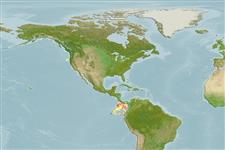Classification / Names
Populärnamn | synonymer | Catalog of Fishes(Släkte, Arter) | ITIS | CoL | WoRMS | Cloffa
>
Ophidiiformes (Cusk eels) >
Ophidiidae (Cusk-eels) > Neobythitinae
Etymology: Porogadus: Greek, poros = porous + Latin, gadus = a fish, cod? (Ref. 45335).
More on author: Garman.
Environment: milieu / climate zone / depth range / distribution range
Ekologi
marina djupbottenlevande; djupintervall 245 - 3300 m (Ref. 125143), usually 1800 - 3300 m (Ref. 125143). Deep-water; 10°N - 0° (Ref. 125143)
Eastern Pacific.
Size / Vikt / Age
Maturity: Lm ? range ? - ? cm
Max length : 46.5 cm SL hane/ej könsbestämd; (Ref. 125143)
Short description
Bestämningsnycklar | Morfologi | Morfometri
This species is distinguished by the following characters: precaudal vertebrae 17-19; lower first gill arch with long gill rakers 11-13; pectoral-fin rays 19-22; HL:HD 1.81-2.08; in small specimens, head spines strong, while in in large specimens short and poorly extruding, present on ethmoidal, lacrimal, prefrontal (weak), interorbital (weak), supraorbital (weak in large specimens), sphenotic, 5th infraorbital, supratemporal (absent in large specimens), inner and outer posttemporal (absent in large specimens), inner and outer preopercular rims (absent in large specimens); opercular spine is sharp, strong, extruding; maxilla with no or few scales at rear; lower lateral line pores until beginning of anal fin 22-24; vomer with a broad dentition patch
(3-9 rows of teeth); palatines with broad dentition patch (2-11 rows of teeth); otolith with separate ostial and caudal colliculi indicated by ventral incision; OL:OH = 1.75-2.1; OL:TCL = 1.8-1.9 (Ref. 125143).
Rare species (Ref. 34024). This species ventures out for about 800 km from the continental break and occurs primarily between 1800 and 3300 m but two specimens were caught in very shallow water at 245 m or near the surface. The reason for the unusual shallow catches are not known (Ref. 125143). Reproductive strategy possibly similar to other members of this family featuring oviparity, with oval pelagic eggs floating in a gelatinous mass (Ref. 205).
Life cycle and mating behavior
Maturities | Reproduktion | Spawnings | Egg(s) | Fecundities | Larver
Schwarzhans, W.W. and P.R. Møller, 2021. Revision of the ‘dragon-head’ cusk eels of the genus Porogadus (Teleostei: Ophidiidae), with description of eight new species and one new genus. Zootaxa 5029(1):001-096. (Ref. 125143)
IUCN Red List Status (Ref. 130435)
Threat to humans
Harmless
Human uses
Fiskeri: saknar intresse
Verktyg
Special reports
Download XML
Internet-källor
Estimates based on models
Preferred temperature (Ref.
123201): 2.6 - 3.1, mean 2.7 °C (based on 6 cells).
Phylogenetic diversity index (Ref.
82804): PD
50 = 0.5001 [Uniqueness, from 0.5 = low to 2.0 = high].
Bayesian length-weight: a=0.00380 (0.00165 - 0.00876), b=3.14 (2.93 - 3.35), in cm total length, based on LWR estimates for this (Sub)family-body shape (Ref.
93245).
Trofisk nivå (Ref.
69278): 3.7 ±0.6 se; based on size and trophs of closest relatives
Resiliens (Ref.
120179): Mellan, lägsta populationsfördubblingstid 1,4-4,4 år (Preliminary K or Fecundity.).
Fishing Vulnerability (Ref.
59153): Moderate vulnerability (43 of 100).
